Nursing Reflection Case Study 2022
VerifiedAdded on 2022/10/04
|10
|2623
|24
AI Summary
Contribute Materials
Your contribution can guide someone’s learning journey. Share your
documents today.
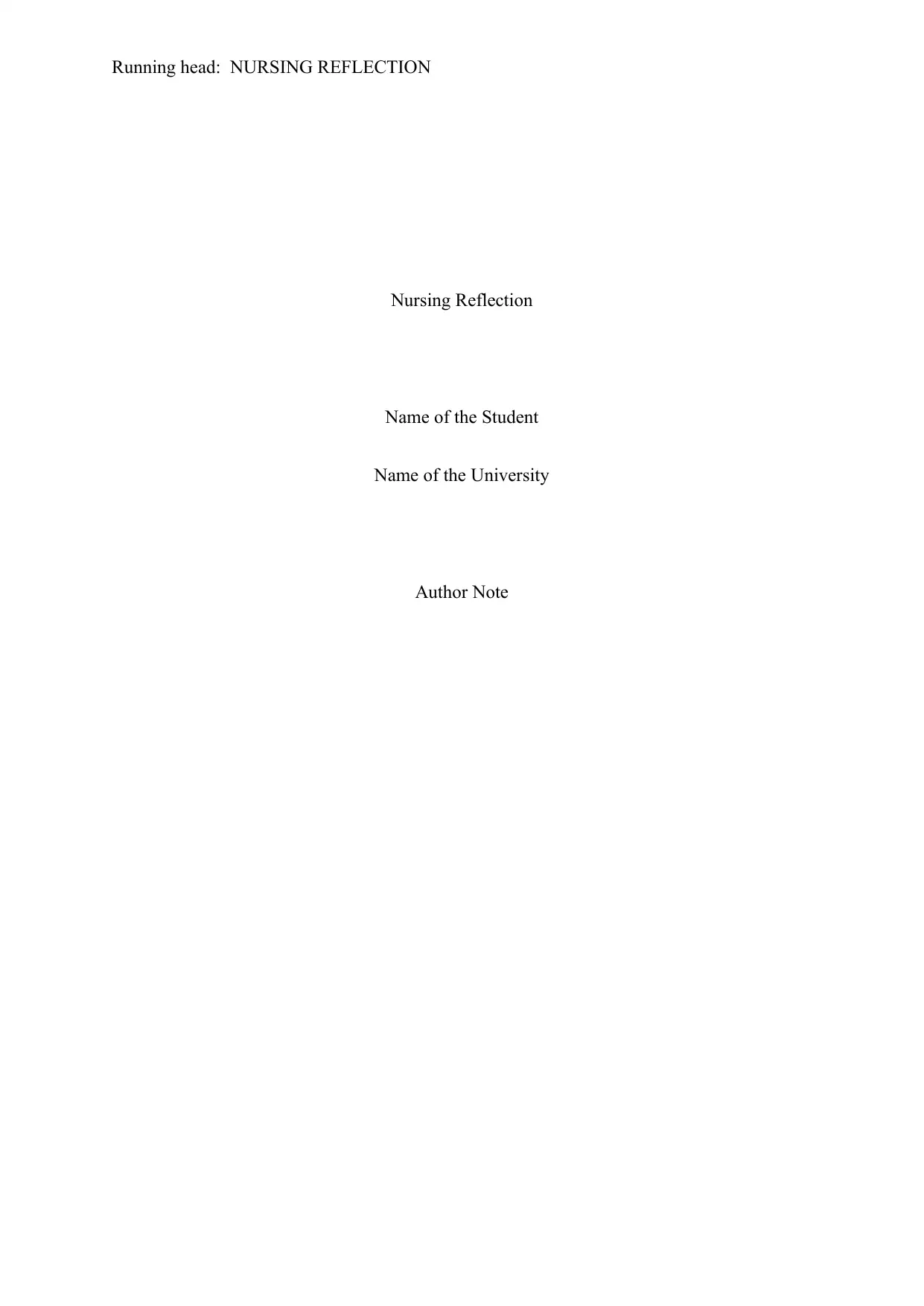
Running head: NURSING REFLECTION
Nursing Reflection
Name of the Student
Name of the University
Author Note
Nursing Reflection
Name of the Student
Name of the University
Author Note
Secure Best Marks with AI Grader
Need help grading? Try our AI Grader for instant feedback on your assignments.
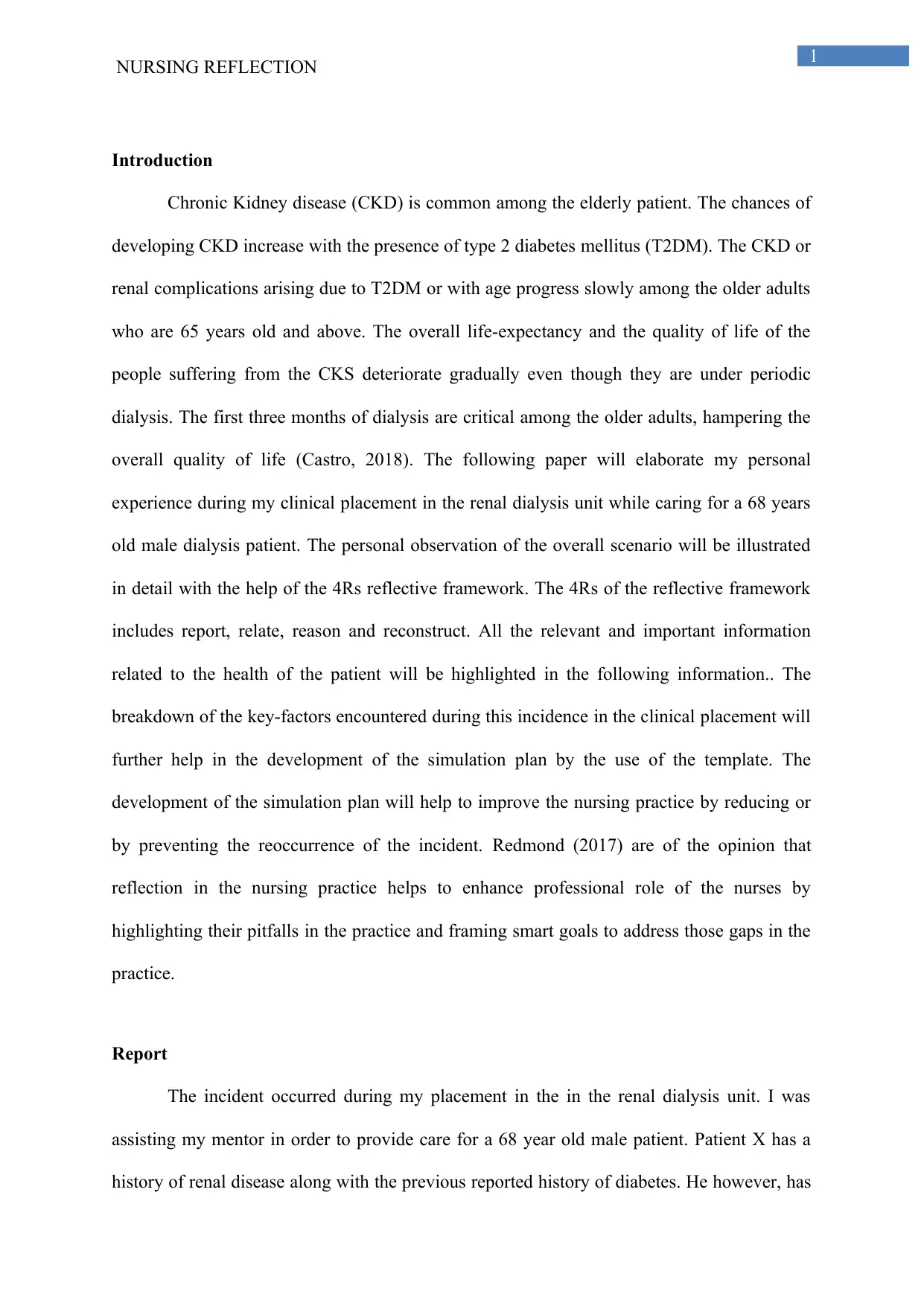
1
NURSING REFLECTION
Introduction
Chronic Kidney disease (CKD) is common among the elderly patient. The chances of
developing CKD increase with the presence of type 2 diabetes mellitus (T2DM). The CKD or
renal complications arising due to T2DM or with age progress slowly among the older adults
who are 65 years old and above. The overall life-expectancy and the quality of life of the
people suffering from the CKS deteriorate gradually even though they are under periodic
dialysis. The first three months of dialysis are critical among the older adults, hampering the
overall quality of life (Castro, 2018). The following paper will elaborate my personal
experience during my clinical placement in the renal dialysis unit while caring for a 68 years
old male dialysis patient. The personal observation of the overall scenario will be illustrated
in detail with the help of the 4Rs reflective framework. The 4Rs of the reflective framework
includes report, relate, reason and reconstruct. All the relevant and important information
related to the health of the patient will be highlighted in the following information.. The
breakdown of the key-factors encountered during this incidence in the clinical placement will
further help in the development of the simulation plan by the use of the template. The
development of the simulation plan will help to improve the nursing practice by reducing or
by preventing the reoccurrence of the incident. Redmond (2017) are of the opinion that
reflection in the nursing practice helps to enhance professional role of the nurses by
highlighting their pitfalls in the practice and framing smart goals to address those gaps in the
practice.
Report
The incident occurred during my placement in the in the renal dialysis unit. I was
assisting my mentor in order to provide care for a 68 year old male patient. Patient X has a
history of renal disease along with the previous reported history of diabetes. He however, has
NURSING REFLECTION
Introduction
Chronic Kidney disease (CKD) is common among the elderly patient. The chances of
developing CKD increase with the presence of type 2 diabetes mellitus (T2DM). The CKD or
renal complications arising due to T2DM or with age progress slowly among the older adults
who are 65 years old and above. The overall life-expectancy and the quality of life of the
people suffering from the CKS deteriorate gradually even though they are under periodic
dialysis. The first three months of dialysis are critical among the older adults, hampering the
overall quality of life (Castro, 2018). The following paper will elaborate my personal
experience during my clinical placement in the renal dialysis unit while caring for a 68 years
old male dialysis patient. The personal observation of the overall scenario will be illustrated
in detail with the help of the 4Rs reflective framework. The 4Rs of the reflective framework
includes report, relate, reason and reconstruct. All the relevant and important information
related to the health of the patient will be highlighted in the following information.. The
breakdown of the key-factors encountered during this incidence in the clinical placement will
further help in the development of the simulation plan by the use of the template. The
development of the simulation plan will help to improve the nursing practice by reducing or
by preventing the reoccurrence of the incident. Redmond (2017) are of the opinion that
reflection in the nursing practice helps to enhance professional role of the nurses by
highlighting their pitfalls in the practice and framing smart goals to address those gaps in the
practice.
Report
The incident occurred during my placement in the in the renal dialysis unit. I was
assisting my mentor in order to provide care for a 68 year old male patient. Patient X has a
history of renal disease along with the previous reported history of diabetes. He however, has
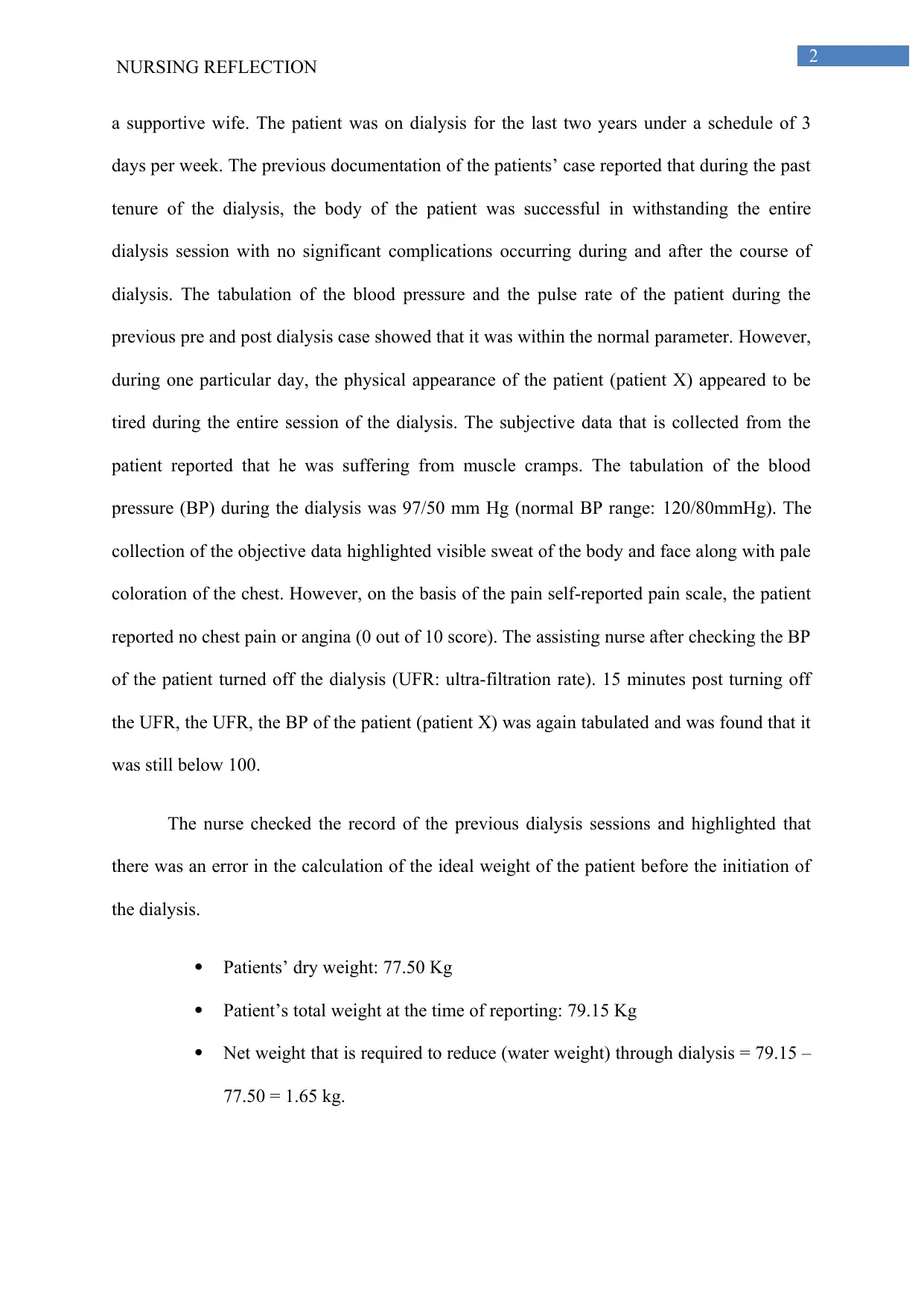
2
NURSING REFLECTION
a supportive wife. The patient was on dialysis for the last two years under a schedule of 3
days per week. The previous documentation of the patients’ case reported that during the past
tenure of the dialysis, the body of the patient was successful in withstanding the entire
dialysis session with no significant complications occurring during and after the course of
dialysis. The tabulation of the blood pressure and the pulse rate of the patient during the
previous pre and post dialysis case showed that it was within the normal parameter. However,
during one particular day, the physical appearance of the patient (patient X) appeared to be
tired during the entire session of the dialysis. The subjective data that is collected from the
patient reported that he was suffering from muscle cramps. The tabulation of the blood
pressure (BP) during the dialysis was 97/50 mm Hg (normal BP range: 120/80mmHg). The
collection of the objective data highlighted visible sweat of the body and face along with pale
coloration of the chest. However, on the basis of the pain self-reported pain scale, the patient
reported no chest pain or angina (0 out of 10 score). The assisting nurse after checking the BP
of the patient turned off the dialysis (UFR: ultra-filtration rate). 15 minutes post turning off
the UFR, the UFR, the BP of the patient (patient X) was again tabulated and was found that it
was still below 100.
The nurse checked the record of the previous dialysis sessions and highlighted that
there was an error in the calculation of the ideal weight of the patient before the initiation of
the dialysis.
Patients’ dry weight: 77.50 Kg
Patient’s total weight at the time of reporting: 79.15 Kg
Net weight that is required to reduce (water weight) through dialysis = 79.15 –
77.50 = 1.65 kg.
NURSING REFLECTION
a supportive wife. The patient was on dialysis for the last two years under a schedule of 3
days per week. The previous documentation of the patients’ case reported that during the past
tenure of the dialysis, the body of the patient was successful in withstanding the entire
dialysis session with no significant complications occurring during and after the course of
dialysis. The tabulation of the blood pressure and the pulse rate of the patient during the
previous pre and post dialysis case showed that it was within the normal parameter. However,
during one particular day, the physical appearance of the patient (patient X) appeared to be
tired during the entire session of the dialysis. The subjective data that is collected from the
patient reported that he was suffering from muscle cramps. The tabulation of the blood
pressure (BP) during the dialysis was 97/50 mm Hg (normal BP range: 120/80mmHg). The
collection of the objective data highlighted visible sweat of the body and face along with pale
coloration of the chest. However, on the basis of the pain self-reported pain scale, the patient
reported no chest pain or angina (0 out of 10 score). The assisting nurse after checking the BP
of the patient turned off the dialysis (UFR: ultra-filtration rate). 15 minutes post turning off
the UFR, the UFR, the BP of the patient (patient X) was again tabulated and was found that it
was still below 100.
The nurse checked the record of the previous dialysis sessions and highlighted that
there was an error in the calculation of the ideal weight of the patient before the initiation of
the dialysis.
Patients’ dry weight: 77.50 Kg
Patient’s total weight at the time of reporting: 79.15 Kg
Net weight that is required to reduce (water weight) through dialysis = 79.15 –
77.50 = 1.65 kg.
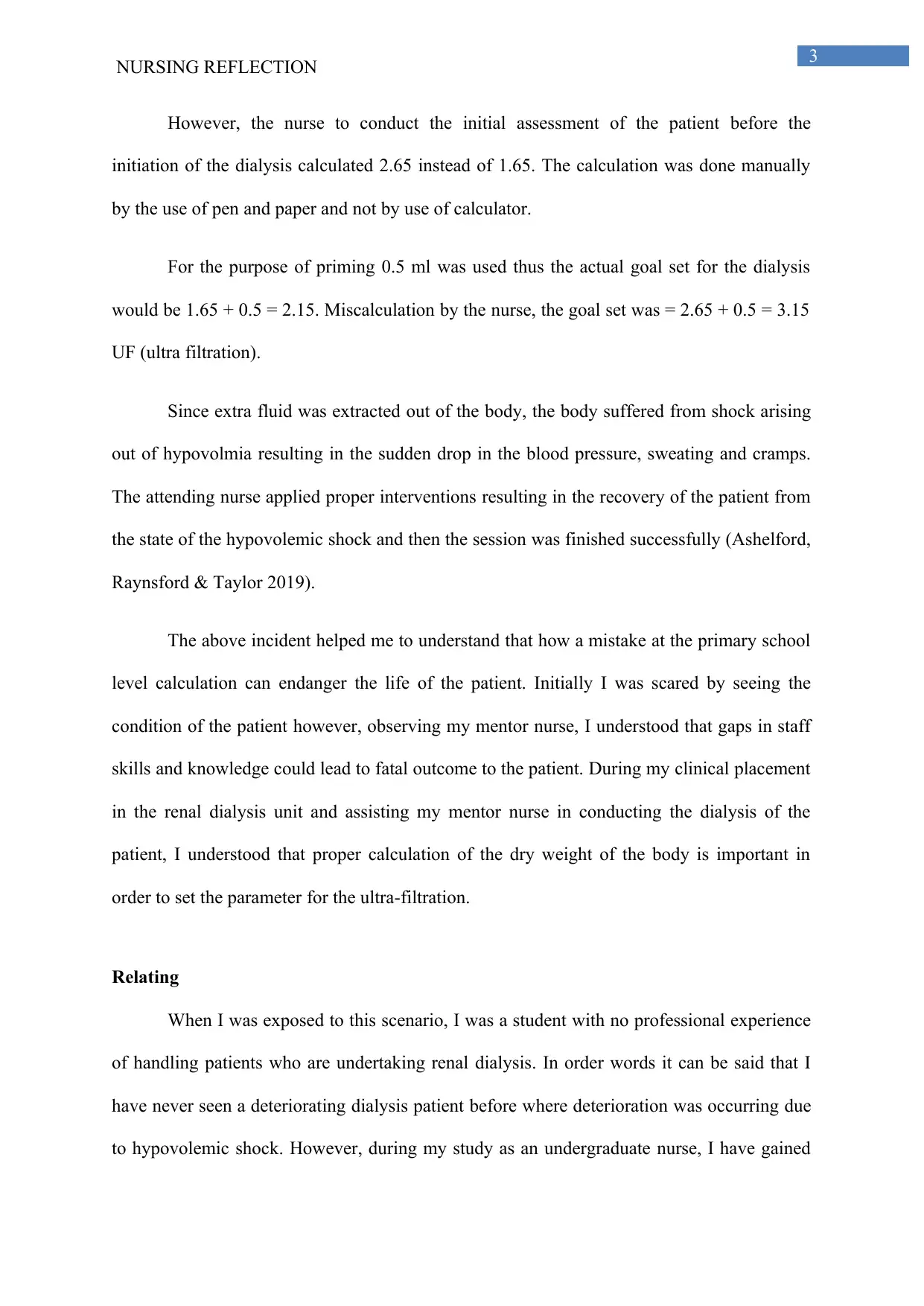
3
NURSING REFLECTION
However, the nurse to conduct the initial assessment of the patient before the
initiation of the dialysis calculated 2.65 instead of 1.65. The calculation was done manually
by the use of pen and paper and not by use of calculator.
For the purpose of priming 0.5 ml was used thus the actual goal set for the dialysis
would be 1.65 + 0.5 = 2.15. Miscalculation by the nurse, the goal set was = 2.65 + 0.5 = 3.15
UF (ultra filtration).
Since extra fluid was extracted out of the body, the body suffered from shock arising
out of hypovolmia resulting in the sudden drop in the blood pressure, sweating and cramps.
The attending nurse applied proper interventions resulting in the recovery of the patient from
the state of the hypovolemic shock and then the session was finished successfully (Ashelford,
Raynsford & Taylor 2019).
The above incident helped me to understand that how a mistake at the primary school
level calculation can endanger the life of the patient. Initially I was scared by seeing the
condition of the patient however, observing my mentor nurse, I understood that gaps in staff
skills and knowledge could lead to fatal outcome to the patient. During my clinical placement
in the renal dialysis unit and assisting my mentor nurse in conducting the dialysis of the
patient, I understood that proper calculation of the dry weight of the body is important in
order to set the parameter for the ultra-filtration.
Relating
When I was exposed to this scenario, I was a student with no professional experience
of handling patients who are undertaking renal dialysis. In order words it can be said that I
have never seen a deteriorating dialysis patient before where deterioration was occurring due
to hypovolemic shock. However, during my study as an undergraduate nurse, I have gained
NURSING REFLECTION
However, the nurse to conduct the initial assessment of the patient before the
initiation of the dialysis calculated 2.65 instead of 1.65. The calculation was done manually
by the use of pen and paper and not by use of calculator.
For the purpose of priming 0.5 ml was used thus the actual goal set for the dialysis
would be 1.65 + 0.5 = 2.15. Miscalculation by the nurse, the goal set was = 2.65 + 0.5 = 3.15
UF (ultra filtration).
Since extra fluid was extracted out of the body, the body suffered from shock arising
out of hypovolmia resulting in the sudden drop in the blood pressure, sweating and cramps.
The attending nurse applied proper interventions resulting in the recovery of the patient from
the state of the hypovolemic shock and then the session was finished successfully (Ashelford,
Raynsford & Taylor 2019).
The above incident helped me to understand that how a mistake at the primary school
level calculation can endanger the life of the patient. Initially I was scared by seeing the
condition of the patient however, observing my mentor nurse, I understood that gaps in staff
skills and knowledge could lead to fatal outcome to the patient. During my clinical placement
in the renal dialysis unit and assisting my mentor nurse in conducting the dialysis of the
patient, I understood that proper calculation of the dry weight of the body is important in
order to set the parameter for the ultra-filtration.
Relating
When I was exposed to this scenario, I was a student with no professional experience
of handling patients who are undertaking renal dialysis. In order words it can be said that I
have never seen a deteriorating dialysis patient before where deterioration was occurring due
to hypovolemic shock. However, during my study as an undergraduate nurse, I have gained
Secure Best Marks with AI Grader
Need help grading? Try our AI Grader for instant feedback on your assignments.
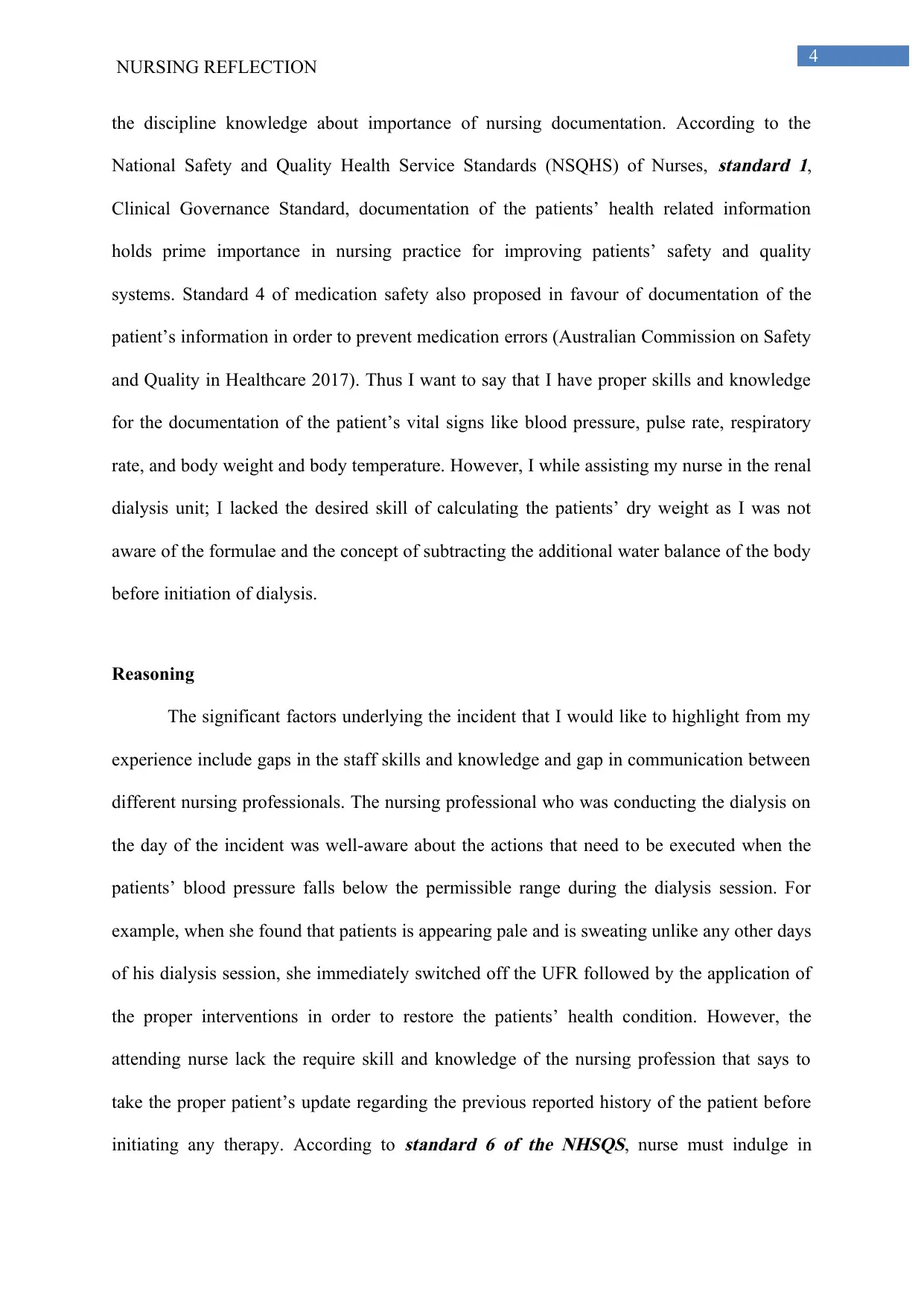
4
NURSING REFLECTION
the discipline knowledge about importance of nursing documentation. According to the
National Safety and Quality Health Service Standards (NSQHS) of Nurses,
standard 1,
Clinical Governance Standard, documentation of the patients’ health related information
holds prime importance in nursing practice for improving patients’ safety and quality
systems. Standard 4 of medication safety also proposed in favour of documentation of the
patient’s information in order to prevent medication errors (Australian Commission on Safety
and Quality in Healthcare 2017). Thus I want to say that I have proper skills and knowledge
for the documentation of the patient’s vital signs like blood pressure, pulse rate, respiratory
rate, and body weight and body temperature. However, I while assisting my nurse in the renal
dialysis unit; I lacked the desired skill of calculating the patients’ dry weight as I was not
aware of the formulae and the concept of subtracting the additional water balance of the body
before initiation of dialysis.
Reasoning
The significant factors underlying the incident that I would like to highlight from my
experience include gaps in the staff skills and knowledge and gap in communication between
different nursing professionals. The nursing professional who was conducting the dialysis on
the day of the incident was well-aware about the actions that need to be executed when the
patients’ blood pressure falls below the permissible range during the dialysis session. For
example, when she found that patients is appearing pale and is sweating unlike any other days
of his dialysis session, she immediately switched off the UFR followed by the application of
the proper interventions in order to restore the patients’ health condition. However, the
attending nurse lack the require skill and knowledge of the nursing profession that says to
take the proper patient’s update regarding the previous reported history of the patient before
initiating any therapy. According to
standard 6 of the NHSQS, nurse must indulge in
NURSING REFLECTION
the discipline knowledge about importance of nursing documentation. According to the
National Safety and Quality Health Service Standards (NSQHS) of Nurses,
standard 1,
Clinical Governance Standard, documentation of the patients’ health related information
holds prime importance in nursing practice for improving patients’ safety and quality
systems. Standard 4 of medication safety also proposed in favour of documentation of the
patient’s information in order to prevent medication errors (Australian Commission on Safety
and Quality in Healthcare 2017). Thus I want to say that I have proper skills and knowledge
for the documentation of the patient’s vital signs like blood pressure, pulse rate, respiratory
rate, and body weight and body temperature. However, I while assisting my nurse in the renal
dialysis unit; I lacked the desired skill of calculating the patients’ dry weight as I was not
aware of the formulae and the concept of subtracting the additional water balance of the body
before initiation of dialysis.
Reasoning
The significant factors underlying the incident that I would like to highlight from my
experience include gaps in the staff skills and knowledge and gap in communication between
different nursing professionals. The nursing professional who was conducting the dialysis on
the day of the incident was well-aware about the actions that need to be executed when the
patients’ blood pressure falls below the permissible range during the dialysis session. For
example, when she found that patients is appearing pale and is sweating unlike any other days
of his dialysis session, she immediately switched off the UFR followed by the application of
the proper interventions in order to restore the patients’ health condition. However, the
attending nurse lack the require skill and knowledge of the nursing profession that says to
take the proper patient’s update regarding the previous reported history of the patient before
initiating any therapy. According to
standard 6 of the NHSQS, nurse must indulge in
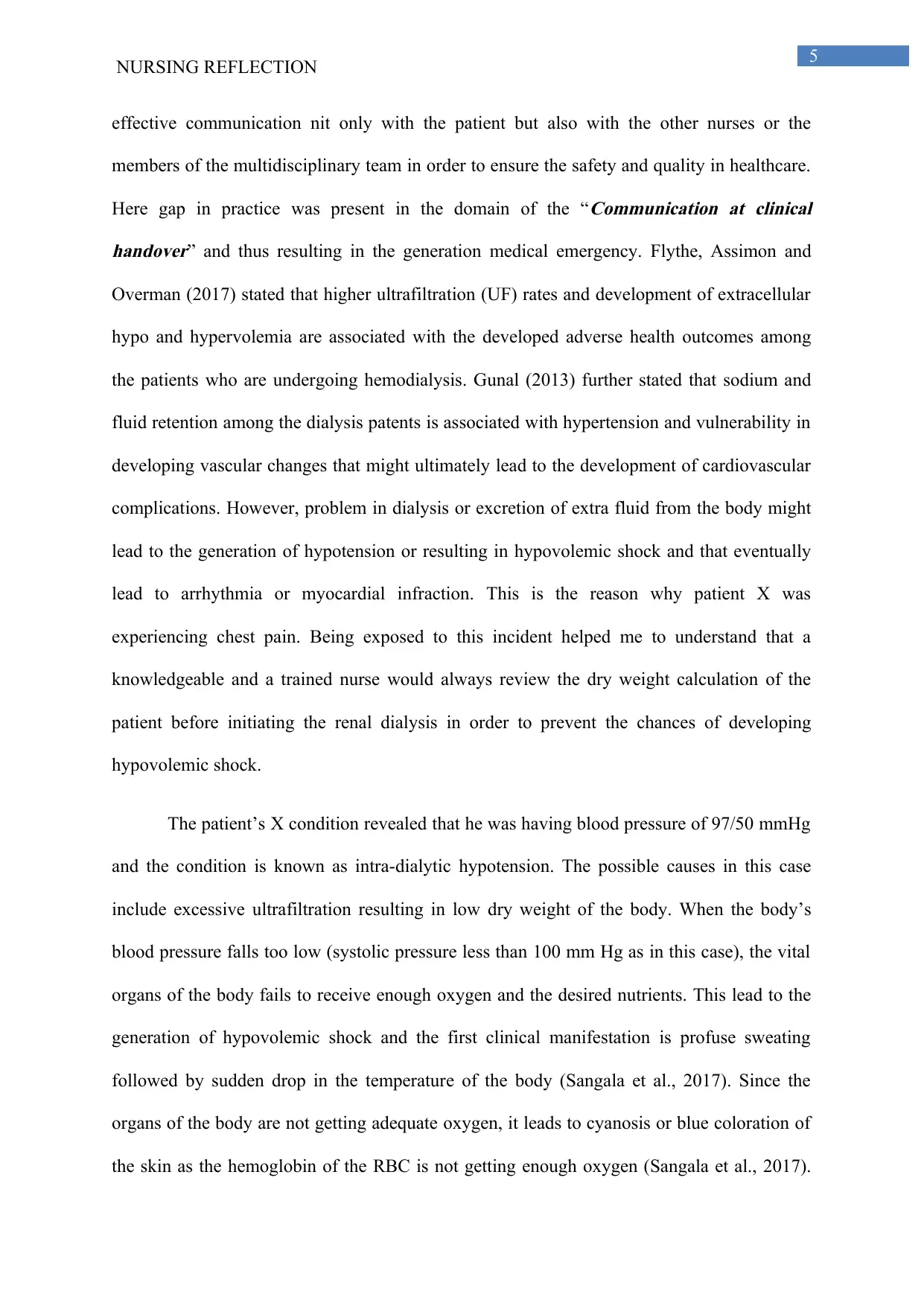
5
NURSING REFLECTION
effective communication nit only with the patient but also with the other nurses or the
members of the multidisciplinary team in order to ensure the safety and quality in healthcare.
Here gap in practice was present in the domain of the “
Communication at clinical
handover” and thus resulting in the generation medical emergency. Flythe, Assimon and
Overman (2017) stated that higher ultrafiltration (UF) rates and development of extracellular
hypo and hypervolemia are associated with the developed adverse health outcomes among
the patients who are undergoing hemodialysis. Gunal (2013) further stated that sodium and
fluid retention among the dialysis patents is associated with hypertension and vulnerability in
developing vascular changes that might ultimately lead to the development of cardiovascular
complications. However, problem in dialysis or excretion of extra fluid from the body might
lead to the generation of hypotension or resulting in hypovolemic shock and that eventually
lead to arrhythmia or myocardial infraction. This is the reason why patient X was
experiencing chest pain. Being exposed to this incident helped me to understand that a
knowledgeable and a trained nurse would always review the dry weight calculation of the
patient before initiating the renal dialysis in order to prevent the chances of developing
hypovolemic shock.
The patient’s X condition revealed that he was having blood pressure of 97/50 mmHg
and the condition is known as intra-dialytic hypotension. The possible causes in this case
include excessive ultrafiltration resulting in low dry weight of the body. When the body’s
blood pressure falls too low (systolic pressure less than 100 mm Hg as in this case), the vital
organs of the body fails to receive enough oxygen and the desired nutrients. This lead to the
generation of hypovolemic shock and the first clinical manifestation is profuse sweating
followed by sudden drop in the temperature of the body (Sangala et al., 2017). Since the
organs of the body are not getting adequate oxygen, it leads to cyanosis or blue coloration of
the skin as the hemoglobin of the RBC is not getting enough oxygen (Sangala et al., 2017).
NURSING REFLECTION
effective communication nit only with the patient but also with the other nurses or the
members of the multidisciplinary team in order to ensure the safety and quality in healthcare.
Here gap in practice was present in the domain of the “
Communication at clinical
handover” and thus resulting in the generation medical emergency. Flythe, Assimon and
Overman (2017) stated that higher ultrafiltration (UF) rates and development of extracellular
hypo and hypervolemia are associated with the developed adverse health outcomes among
the patients who are undergoing hemodialysis. Gunal (2013) further stated that sodium and
fluid retention among the dialysis patents is associated with hypertension and vulnerability in
developing vascular changes that might ultimately lead to the development of cardiovascular
complications. However, problem in dialysis or excretion of extra fluid from the body might
lead to the generation of hypotension or resulting in hypovolemic shock and that eventually
lead to arrhythmia or myocardial infraction. This is the reason why patient X was
experiencing chest pain. Being exposed to this incident helped me to understand that a
knowledgeable and a trained nurse would always review the dry weight calculation of the
patient before initiating the renal dialysis in order to prevent the chances of developing
hypovolemic shock.
The patient’s X condition revealed that he was having blood pressure of 97/50 mmHg
and the condition is known as intra-dialytic hypotension. The possible causes in this case
include excessive ultrafiltration resulting in low dry weight of the body. When the body’s
blood pressure falls too low (systolic pressure less than 100 mm Hg as in this case), the vital
organs of the body fails to receive enough oxygen and the desired nutrients. This lead to the
generation of hypovolemic shock and the first clinical manifestation is profuse sweating
followed by sudden drop in the temperature of the body (Sangala et al., 2017). Since the
organs of the body are not getting adequate oxygen, it leads to cyanosis or blue coloration of
the skin as the hemoglobin of the RBC is not getting enough oxygen (Sangala et al., 2017).
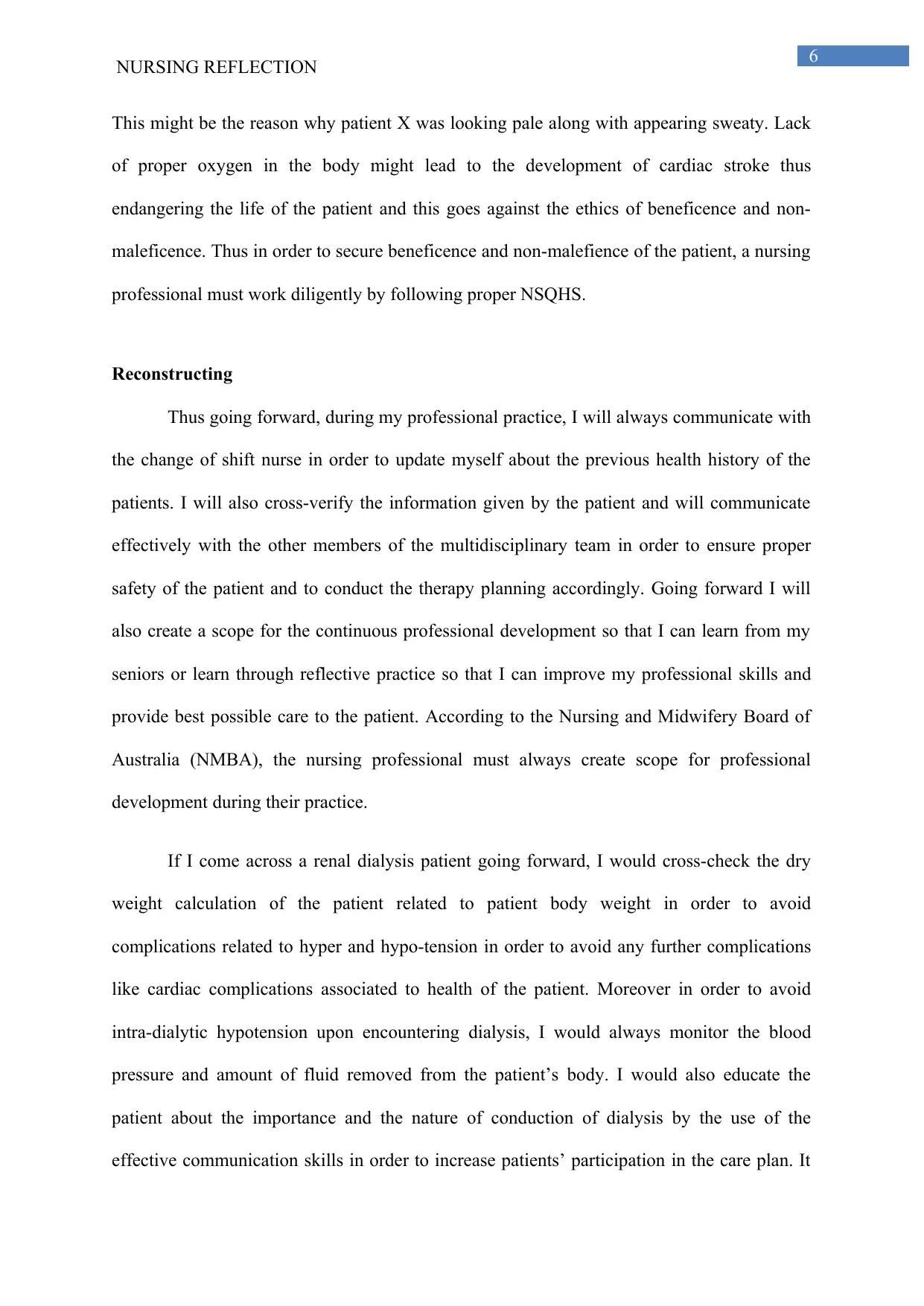
6
NURSING REFLECTION
This might be the reason why patient X was looking pale along with appearing sweaty. Lack
of proper oxygen in the body might lead to the development of cardiac stroke thus
endangering the life of the patient and this goes against the ethics of beneficence and non-
maleficence. Thus in order to secure beneficence and non-malefience of the patient, a nursing
professional must work diligently by following proper NSQHS.
Reconstructing
Thus going forward, during my professional practice, I will always communicate with
the change of shift nurse in order to update myself about the previous health history of the
patients. I will also cross-verify the information given by the patient and will communicate
effectively with the other members of the multidisciplinary team in order to ensure proper
safety of the patient and to conduct the therapy planning accordingly. Going forward I will
also create a scope for the continuous professional development so that I can learn from my
seniors or learn through reflective practice so that I can improve my professional skills and
provide best possible care to the patient. According to the Nursing and Midwifery Board of
Australia (NMBA), the nursing professional must always create scope for professional
development during their practice.
If I come across a renal dialysis patient going forward, I would cross-check the dry
weight calculation of the patient related to patient body weight in order to avoid
complications related to hyper and hypo-tension in order to avoid any further complications
like cardiac complications associated to health of the patient. Moreover in order to avoid
intra-dialytic hypotension upon encountering dialysis, I would always monitor the blood
pressure and amount of fluid removed from the patient’s body. I would also educate the
patient about the importance and the nature of conduction of dialysis by the use of the
effective communication skills in order to increase patients’ participation in the care plan. It
NURSING REFLECTION
This might be the reason why patient X was looking pale along with appearing sweaty. Lack
of proper oxygen in the body might lead to the development of cardiac stroke thus
endangering the life of the patient and this goes against the ethics of beneficence and non-
maleficence. Thus in order to secure beneficence and non-malefience of the patient, a nursing
professional must work diligently by following proper NSQHS.
Reconstructing
Thus going forward, during my professional practice, I will always communicate with
the change of shift nurse in order to update myself about the previous health history of the
patients. I will also cross-verify the information given by the patient and will communicate
effectively with the other members of the multidisciplinary team in order to ensure proper
safety of the patient and to conduct the therapy planning accordingly. Going forward I will
also create a scope for the continuous professional development so that I can learn from my
seniors or learn through reflective practice so that I can improve my professional skills and
provide best possible care to the patient. According to the Nursing and Midwifery Board of
Australia (NMBA), the nursing professional must always create scope for professional
development during their practice.
If I come across a renal dialysis patient going forward, I would cross-check the dry
weight calculation of the patient related to patient body weight in order to avoid
complications related to hyper and hypo-tension in order to avoid any further complications
like cardiac complications associated to health of the patient. Moreover in order to avoid
intra-dialytic hypotension upon encountering dialysis, I would always monitor the blood
pressure and amount of fluid removed from the patient’s body. I would also educate the
patient about the importance and the nature of conduction of dialysis by the use of the
effective communication skills in order to increase patients’ participation in the care plan. It
Paraphrase This Document
Need a fresh take? Get an instant paraphrase of this document with our AI Paraphraser
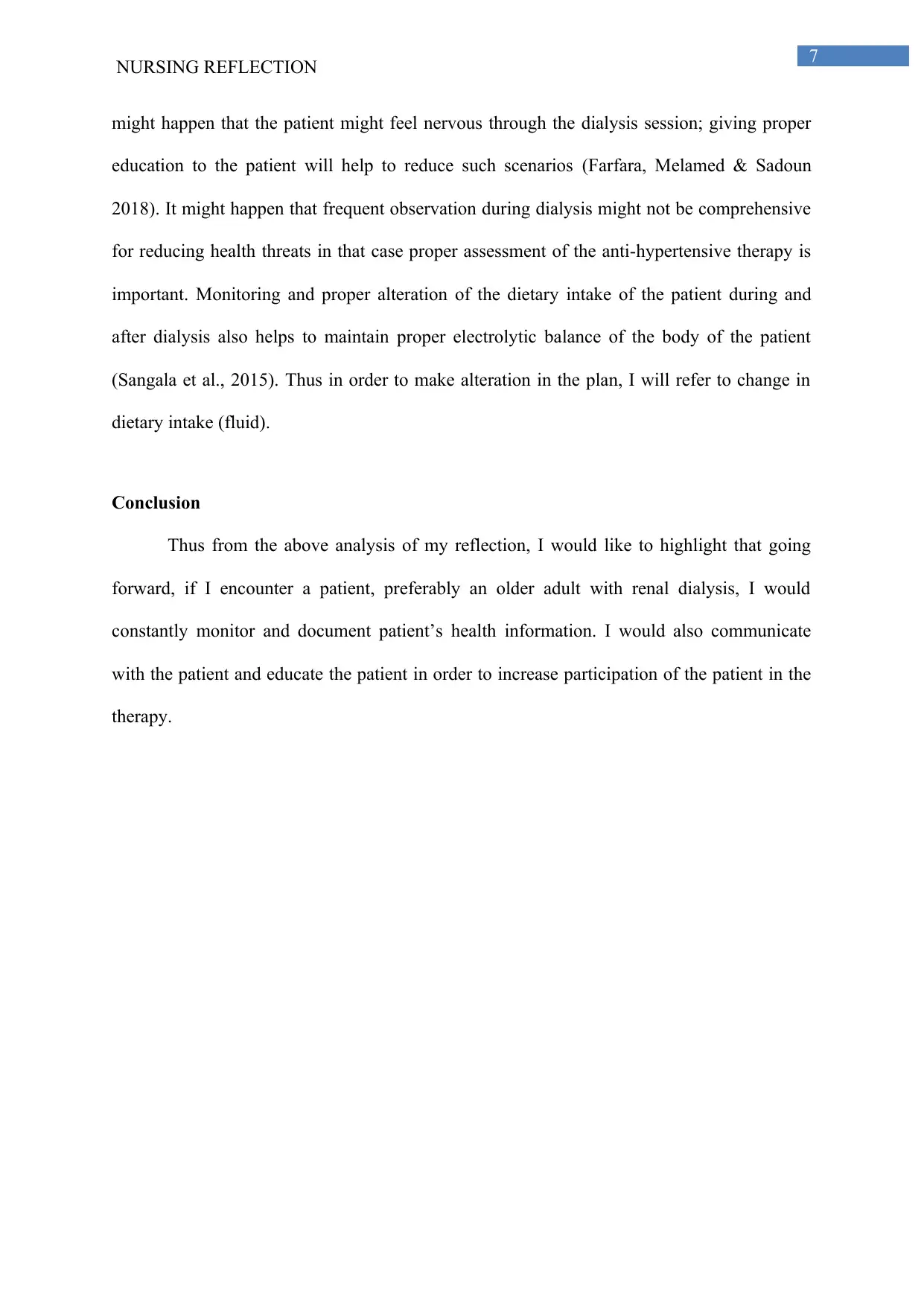
7
NURSING REFLECTION
might happen that the patient might feel nervous through the dialysis session; giving proper
education to the patient will help to reduce such scenarios (Farfara, Melamed & Sadoun
2018). It might happen that frequent observation during dialysis might not be comprehensive
for reducing health threats in that case proper assessment of the anti-hypertensive therapy is
important. Monitoring and proper alteration of the dietary intake of the patient during and
after dialysis also helps to maintain proper electrolytic balance of the body of the patient
(Sangala et al., 2015). Thus in order to make alteration in the plan, I will refer to change in
dietary intake (fluid).
Conclusion
Thus from the above analysis of my reflection, I would like to highlight that going
forward, if I encounter a patient, preferably an older adult with renal dialysis, I would
constantly monitor and document patient’s health information. I would also communicate
with the patient and educate the patient in order to increase participation of the patient in the
therapy.
NURSING REFLECTION
might happen that the patient might feel nervous through the dialysis session; giving proper
education to the patient will help to reduce such scenarios (Farfara, Melamed & Sadoun
2018). It might happen that frequent observation during dialysis might not be comprehensive
for reducing health threats in that case proper assessment of the anti-hypertensive therapy is
important. Monitoring and proper alteration of the dietary intake of the patient during and
after dialysis also helps to maintain proper electrolytic balance of the body of the patient
(Sangala et al., 2015). Thus in order to make alteration in the plan, I will refer to change in
dietary intake (fluid).
Conclusion
Thus from the above analysis of my reflection, I would like to highlight that going
forward, if I encounter a patient, preferably an older adult with renal dialysis, I would
constantly monitor and document patient’s health information. I would also communicate
with the patient and educate the patient in order to increase participation of the patient in the
therapy.
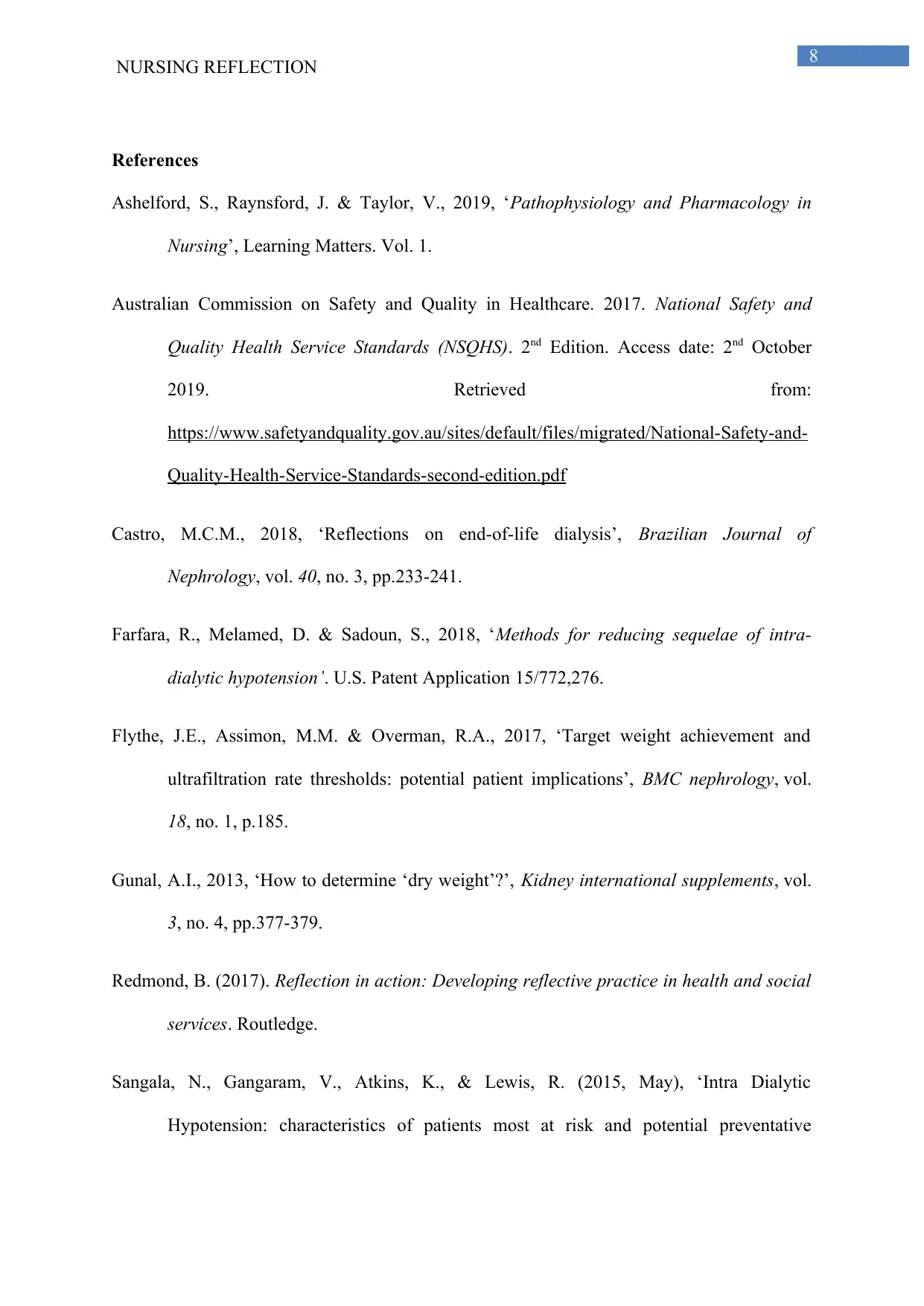
8
NURSING REFLECTION
References
Ashelford, S., Raynsford, J. & Taylor, V., 2019, ‘Pathophysiology and Pharmacology in
Nursing’, Learning Matters. Vol. 1.
Australian Commission on Safety and Quality in Healthcare. 2017. National Safety and
Quality Health Service Standards (NSQHS). 2nd Edition. Access date: 2nd October
2019. Retrieved from:
https://www.safetyandquality.gov.au/sites/default/files/migrated/National-Safety-and-
Quality-Health-Service-Standards-second-edition.pdf
Castro, M.C.M., 2018, ‘Reflections on end-of-life dialysis’, Brazilian Journal of
Nephrology, vol. 40, no. 3, pp.233-241.
Farfara, R., Melamed, D. & Sadoun, S., 2018, ‘Methods for reducing sequelae of intra-
dialytic hypotension’. U.S. Patent Application 15/772,276.
Flythe, J.E., Assimon, M.M. & Overman, R.A., 2017, ‘Target weight achievement and
ultrafiltration rate thresholds: potential patient implications’, BMC nephrology, vol.
18, no. 1, p.185.
Gunal, A.I., 2013, ‘How to determine ‘dry weight’?’, Kidney international supplements, vol.
3, no. 4, pp.377-379.
Redmond, B. (2017). Reflection in action: Developing reflective practice in health and social
services. Routledge.
Sangala, N., Gangaram, V., Atkins, K., & Lewis, R. (2015, May), ‘Intra Dialytic
Hypotension: characteristics of patients most at risk and potential preventative
NURSING REFLECTION
References
Ashelford, S., Raynsford, J. & Taylor, V., 2019, ‘Pathophysiology and Pharmacology in
Nursing’, Learning Matters. Vol. 1.
Australian Commission on Safety and Quality in Healthcare. 2017. National Safety and
Quality Health Service Standards (NSQHS). 2nd Edition. Access date: 2nd October
2019. Retrieved from:
https://www.safetyandquality.gov.au/sites/default/files/migrated/National-Safety-and-
Quality-Health-Service-Standards-second-edition.pdf
Castro, M.C.M., 2018, ‘Reflections on end-of-life dialysis’, Brazilian Journal of
Nephrology, vol. 40, no. 3, pp.233-241.
Farfara, R., Melamed, D. & Sadoun, S., 2018, ‘Methods for reducing sequelae of intra-
dialytic hypotension’. U.S. Patent Application 15/772,276.
Flythe, J.E., Assimon, M.M. & Overman, R.A., 2017, ‘Target weight achievement and
ultrafiltration rate thresholds: potential patient implications’, BMC nephrology, vol.
18, no. 1, p.185.
Gunal, A.I., 2013, ‘How to determine ‘dry weight’?’, Kidney international supplements, vol.
3, no. 4, pp.377-379.
Redmond, B. (2017). Reflection in action: Developing reflective practice in health and social
services. Routledge.
Sangala, N., Gangaram, V., Atkins, K., & Lewis, R. (2015, May), ‘Intra Dialytic
Hypotension: characteristics of patients most at risk and potential preventative
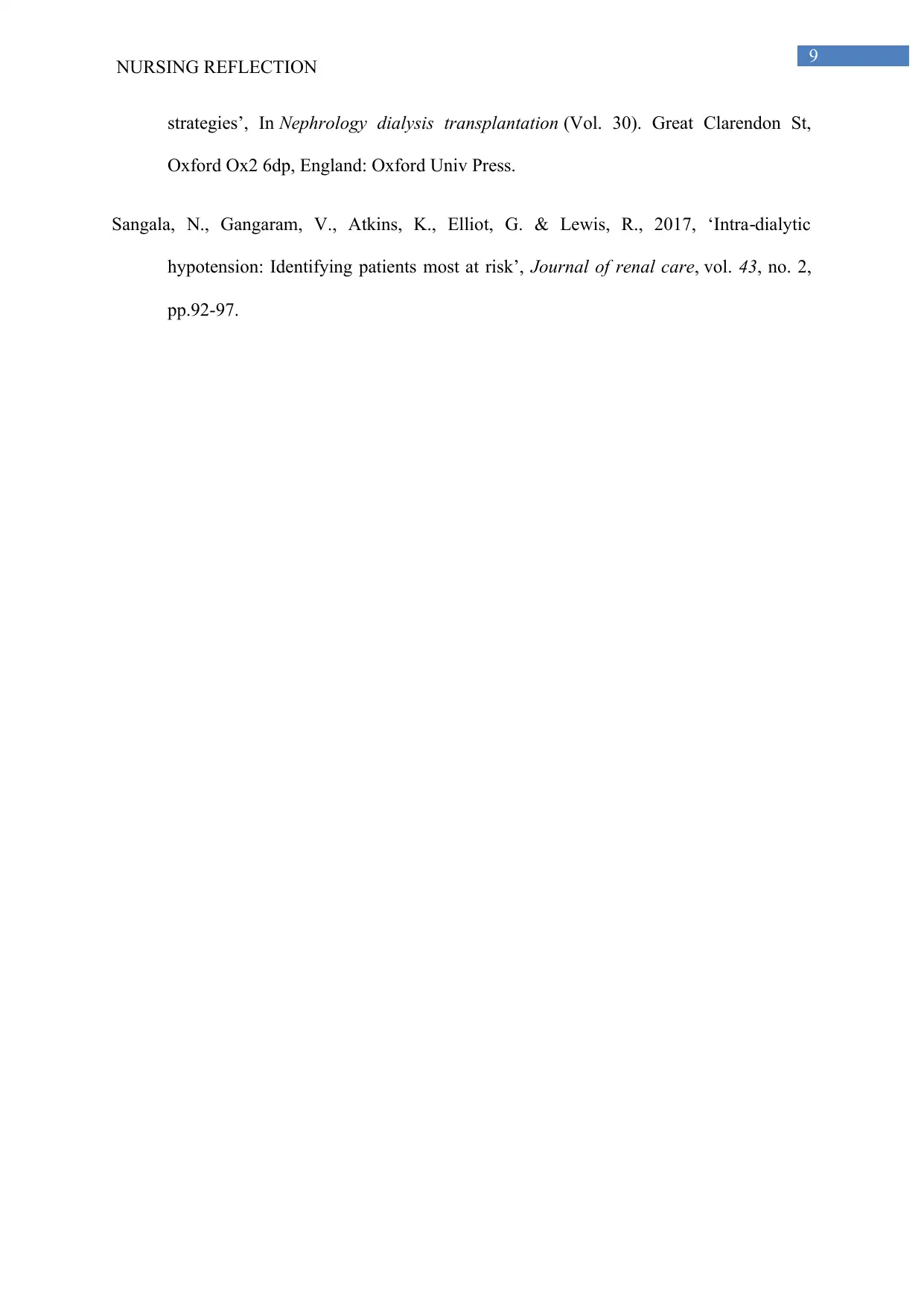
9
NURSING REFLECTION
strategies’, In Nephrology dialysis transplantation (Vol. 30). Great Clarendon St,
Oxford Ox2 6dp, England: Oxford Univ Press.
Sangala, N., Gangaram, V., Atkins, K., Elliot, G. & Lewis, R., 2017, ‘Intra dialytic‐
hypotension: Identifying patients most at risk’, Journal of renal care, vol. 43, no. 2,
pp.92-97.
NURSING REFLECTION
strategies’, In Nephrology dialysis transplantation (Vol. 30). Great Clarendon St,
Oxford Ox2 6dp, England: Oxford Univ Press.
Sangala, N., Gangaram, V., Atkins, K., Elliot, G. & Lewis, R., 2017, ‘Intra dialytic‐
hypotension: Identifying patients most at risk’, Journal of renal care, vol. 43, no. 2,
pp.92-97.
1 out of 10
Your All-in-One AI-Powered Toolkit for Academic Success.
+13062052269
info@desklib.com
Available 24*7 on WhatsApp / Email
![[object Object]](/_next/static/media/star-bottom.7253800d.svg)
Unlock your academic potential
© 2024 | Zucol Services PVT LTD | All rights reserved.
